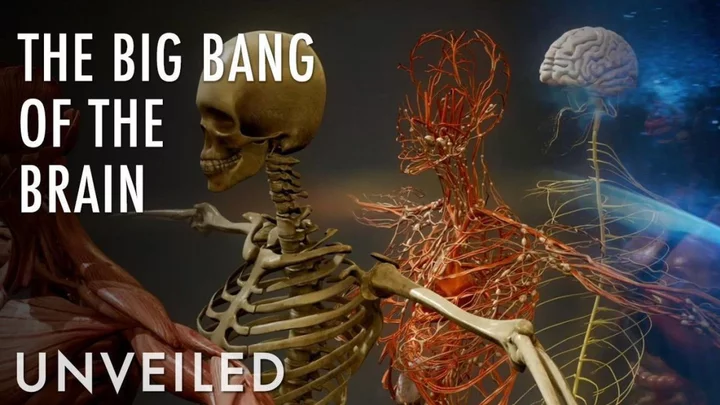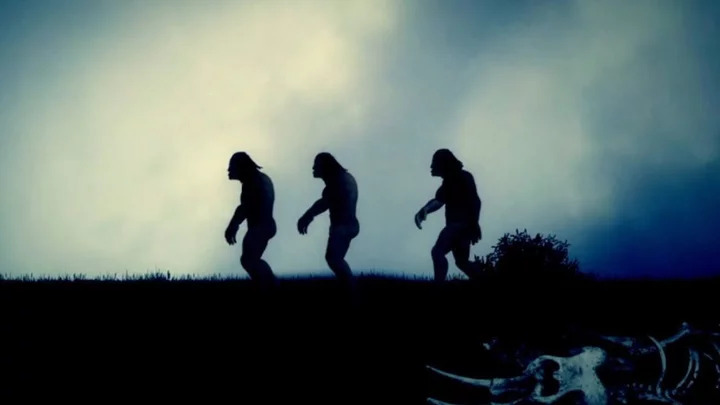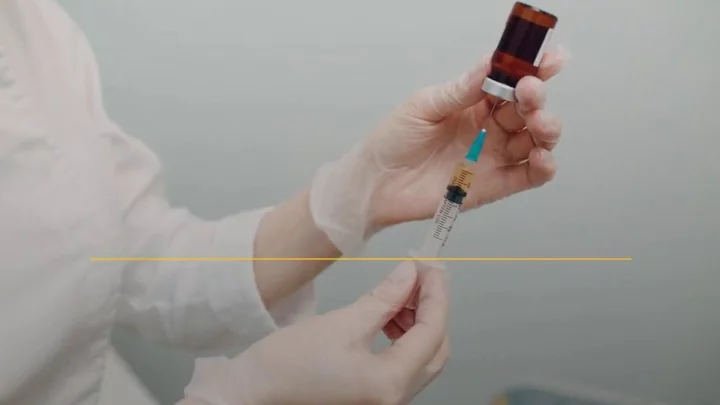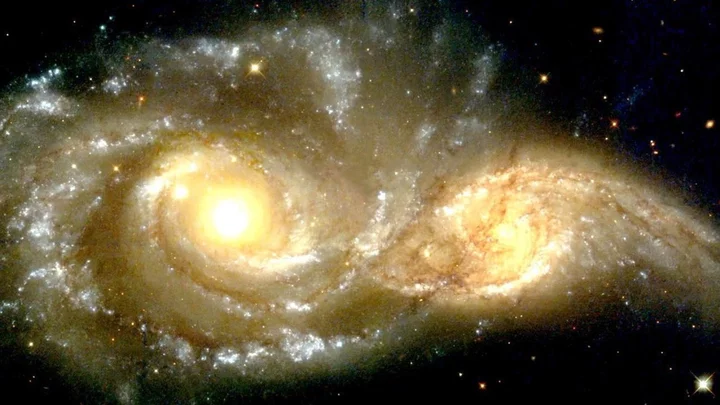
Scientists confused after black holes 'burp up' previously destroyed stars
It feels like every time black holes are discussed and studied by the scientific community, there are new findings that blow our tiny minds. It’s been revealed that black holes actually regurgitate or “burp up” the stars that they eat years after the event. Experts made the discovery by studying tidal disruption events (TDEs). These events take place when stars are close enough to supermassive black holes, to be destroyed by the process of spaghettification. Studying these moments over a number of years after the black holes seemingly swallowing stars with no trace, the experts found that up to 50 per cent of them "burp up" the remains. Yvette Cendes is a research associate at the Havard and Smithsonian Center for Astrophysics and head author on the study. Speaking to Live Science, she said: "If you look years later, a very, very large fraction of these black holes that don’t have radio emission at these early times will actually suddenly 'turn on' in radio waves. "I call it a 'burp' because we’re having some sort of delay where this material is not coming out of the accretion disk until much later than people were anticipating." The material was re-emitted between two and six years from 10 out of 24 black holes which were studied by Cendes and the team. It has the potential to change the way the scientific community thinks about black holes. "There was a second peak, the two black holes re-brightened, and that's completely new and unexpected," Cendes said. "People were thinking that you'd have one outflow, and then it's kind of done. So this observation means these black holes can 'turn on' and then 'turn on' again." Meanwhile, a low intergalactic grumbling is emanating from deep space, according to scientists – and again, it’s black holes that are providing us with new discoveries. Astronomers say they detected the first-of-their-kind low frequency ripples, described as a “cosmic bass note” of gravitational waves, which is thought to be caused by supermassive black holes merging across the universe. Sign up for our free Indy100 weekly newsletter Have your say in our news democracy. Click the upvote icon at the top of the page to help raise this article through the indy100 rankings
2023-09-07 00:21

Frozen humans could be brought back to life in next 50 years claims expert
Experts may have found a way to resurrect frozen humans in 50 to 70 years. It comes after a cryonics company was able to revive an extinct worm from 46,000 years ago, leading them to believe the method could be applied to humans. "Cryonics is a scientifically based, legal technology for preserving humans and animals in a state of deep cooling in the hope that in the future they will be resuscitated and, if necessary, cured and rejuvenated," Russian cryogenics company KrioRus explained. "For legal reasons, human cryopreservation can be carried out only after legal death." KrioRus shared how the dead patient is "immersed into a low-temperature medium where almost all chemical reactions are stopped." The first ever cryopatient, American professor James Bedford, has been preserved for almost 50 years "with no sign of change or deterioration." "In the prognosis of modern science, a cryopatient can indeed be someday revived and return to life," they said. Many more people have opted to freeze their deceased pets, with costs dependent on pet size, species and distance to the facility among other factors. A dog is said to cost around $25,000. The company claims to have cryopreserved 92 people but disclaimed that for humans to be resurrected, there must be significant progress in the medical field. "Cryobiological laboratories are few, there are no large ones at all," CEO Valeriya Udalova told MailOnline. "Even the famous laboratory 'XXI Century Medicine' is a small organization." She continued: "But even in such a deplorable situation, remarkable experiments have already been made, for example, on reversible cryopreservation of a rat kidney using gas persufflation with nanoparticles and induction heating." Sign up for our free Indy100 weekly newsletter Have your say in our news democracy. Click the upvote icon at the top of the page to help raise this article through the indy100 rankings.
2023-09-06 21:15

Curly hair may have been critical to human evolution
Curly hair may have been absolutely critical to humans evolving millions of years ago, scientists have discovered. In fact, having curly hair could have been the key reason as to why humans developed, grew taller and came to have larger brains. It’s all to do with regulating body temperature, according to a new study by researchers at Penn State University. Given that hair can help to protect the head from the sun’s rays, it’s thought that thicker, curlier hair types could have been key to human life progressing in Equatorial Africa. Scientists recreated the kinds of conditions that early humans would have experienced, using wigs featuring different hair types on models. They found that curls were most effective in keeping the models cool in an environment measuring 86 degrees Fahrenheit (30 degrees Celsius) and 60 per cent humidity. Tina Lasisi is the study's lead author. She spoke to Newsweek about the findings and said: "We hypothesized that tightly curled scalp hair would provide some benefits, but the extent of these benefits was uncertain. "Previous studies on mammalian coats have shown that hair can limit the amount of sunlight reaching the skin, but we were particularly surprised by the significant reduction in solar heat radiation impact provided by tightly coiled hair.” The reduction in heat caused by tight curls could have led to the development of larger brains. "Once humans developed large brains, they could employ other behavioral and social strategies to cope with heat, potentially diminishing the relative advantage of curly hair," she said. "This could have led to a diverse distribution of hair textures worldwide. Furthermore, since straight hair better retains heat, populations in colder environments may have experienced selective pressure for straight hair." She added: "Future research should aim to answer these questions by incorporating our data into mathematical models of human physiology or conducting experiments with human subjects who have different hair textures to examine the impact on their thermal regulation.” Sign up for our free Indy100 weekly newsletter Have your say in our news democracy. Click the upvote icon at the top of the page to help raise this article through the indy100 rankings
2023-09-06 00:50

Mysterious 'golden egg' discovered at the bottom of the ocean leaves scientists baffled
A mysterious golden object has been found at the bottom of the ocean by scientists exploring the Pacific Ocean and it has left them baffled. The discovery was made on 30 August when a team of experts from the National Oceanic and Atmospheric Administration (NOAA) were taking a closer look at an underwater volcano 250 miles off the coast of Alaska. Experts, and members of the public viewing the live stream, caught a glimpse of the unusual gold orb two miles beneath the surface lodged into the side of the volcano and were left puzzled over what it could be. It was found thanks to the NOAA’s Seascape Alaska 5 expedition that is currently mapping the seafloor of the Gulf of Alaska. Those who made the discovery at the foot of the volcano also noted there was a mysterious hole in the side of the orb, with one researcher suggesting on the live stream that “Something tried to get in...or to get out”. Scientists bantered back and forth about what the egg-like object could be and ultimately decided to take a sample that could be analysed. The texture of the orb was not as they had expected and was more of a silky, delicate consistency. An arm from the robotic vehicle was used to suction the orb in order for scientists to determine its origins with laboratory testing. The NOAA Seascape Alaska 5 expedition is due to end in mid-September and aims to fill the gaps that experts have about the sea beds off the USA’s west coast. It began on 24 August in Kodiak, Alaska and will come to an end in Seward, Alaska on 16 September. Sign up to our free Indy100 weekly newsletter Have your say in our news democracy. Click the upvote icon at the top of the page to help raise this article through the indy100 rankings.
2023-09-05 22:57

Scientists find that vitamins might be having an adverse impact on your health
Growing up, people are generally taught that taking vitamins is good for you, with many people taking supplements to boost their intake. However, results of a new study suggest that taking vitamins could actually have a negative impact on health as they may help tumours to grow. New research suggests that taking additional vitamins and minerals, including common antioxidants such as vitamins A and C, and selenium and zinc, could help the blood vessels in tumours to grow. The study was conducted by scientists at the Karolinska Institutet in Sweden who published their findings in the Journal of Clinical Investigation. The results were somewhat of a surprise to experts, who believed anti-oxidants to be protective of the body. In their research, they found that vitamin C and other antioxidants actually stimulated the formation of new blood vessels in lung cancer tumours. Martin Bergö, who is a professor at the Department of Biosciences and Nutrition, said: “We’ve found that antioxidants activate a mechanism that causes cancer tumours to form new blood vessels, which is surprising since it was previously thought that antioxidants have a protective effect. “The new blood vessels nourish the tumours and can help them grow and spread.” Antioxidants, in normal amounts, neutralise free oxygen radicals that damage the body, so are beneficial. But, scientists found that high doses of antioxidants can activate a protein called BACH1 which begins the formation of new blood vessels, allowing harmful tumours to grow. Bergö explained: “There’s no need to fear antioxidants in normal food but most people don’t need additional amounts of them. “In fact, it can be harmful for cancer patients and people with an elevated cancer risk.” Ting Wang, the study’s lead author, said: “Many clinical trials have evaluated the efficacy of angiogenesis inhibitors, but the results have not been as successful as anticipated. “Our study opens the door to more effective ways of preventing angiogenesis in tumours; for example, patients whose tumours exhibit high levels of BACH1 might benefit more from anti-angiogenesis therapy than patients with low BACH1 levels.” Sign up to our free Indy100 weekly newsletter Have your say in our news democracy. Click the upvote icon at the top of the page to help raise this article through the indy100 rankings.
2023-09-05 20:22

The Moon is slowly drifting away from Earth and its beginning to impact us
The Moon is a constant in the night sky, but all is not actually as it seems. It turns out that scientists have discovered the Moon is drifting away from Earth, and it’s changing everything we thought we knew about our planet’s relationship with its only natural satellite. It’s also having a very real impact on the length of days on our planet – albeit at an incredibly slow rate. By moving away from Earth over the course of millions of years, the Moon is simultaneously making the length of the average day longer. A study by a team at the University of Wisconsin-Madison focused on rock from a formation aged at 90 million years. By doing so, they were able to analyse the Earth’s interactions with the Moon 1.4 billion years ago. It turns out that the Moon is moving away from Earth at us at 3.82 centimetres a year. That means that, eventually, it’ll result in Earth days lasting 25 hours in 200 million years time. Stephen Meyers, who is a professor of geoscience at the University of Wisconsin-Madison, said: “As the moon moves away, the Earth is like a spinning figure skater who slows down as they stretch their arms out.” He added: “One of our ambitions was to use astrochronology to tell time in the most distant past, to develop very ancient geological time scales. “We want to be able to study rocks that are billions of years old in a way that is comparable to how we study modern geologic processes.” It’s not the only story that changes our understanding of the Moon recently. Scientists have also just uncovered billions of years’ worth of secrets buried beneath the surface of the moon – all thanks to China’s space programme, which has uncovered hidden structures which can help us start to piece together the Moon’s past. Sign up for our free Indy100 weekly newsletter Have your say in our news democracy. Click the upvote icon at the top of the page to help raise this article through the indy100 rankings
2023-09-04 20:21

The terrifying time our early ancestors almost became extinct
New research has shown that our early ancestors almost went extinct some 900,000 years ago. Using a new method called FitCoal (fast infinitesimal time coalescent process), researchers analysed the likelihood of present-day genome sequences to project current human genomic variation backwards in time. They applied the technique to the genomes of 3,154 people from 10 African and 40 non-African populations, and found a massive crash in genetic diversity during the transition between the early and middle Pleistocene. “Results showed that human ancestors went through a severe population bottleneck with about 1,280 breeding individuals between around 930,000 and 813,000 years ago,” the study authors wrote in the journal Science. “The bottleneck lasted for about 117,000 years and brought human ancestors close to extinction,” they say. Wiping out roughly 98.7 percent of the ancestral human population, “the bottleneck could also have increased the inbreeding level of our ancestors, thus contributing to the 65.85 percent loss in present-day human genetic diversity,” explained the researchers. This probably happened because of changes in the global climate as short-term glaciations became longer-lasting, triggering a drop in ocean temperatures, prolonged drought, and the loss of large numbers of species that humans might have relied on for food. Then, around 813,000 years ago, populations finally recovered, with a 20-fold increase in numbers because of fire combined with the return of warmer temperatures, researchers reckon. What a near miss, eh? Sign up to our free Indy100 weekly newsletter Have your say in our news democracy. Click the upvote icon at the top of the page to help raise this article through the indy100 rankings.
2023-09-03 19:22

Scientists believe they have found a cure for alcoholism
Alcohol addiction ruins millions of lives every year, but scientists may have found a cure for this terrible affliction. A new treatment for alcohol use disorder (AUD) has been trialled in monkeys with impressive results and, if these translate to human trials, the impact could be monumental. A team of neuroscientists and physiologists from across the US tested a new type of gene therapy to see if they could directly target the underlying brain circuitry associated with sustained heavy drinking. As they noted, in the journal Nature Medicine, people suffering from AUD commonly return to alcohol use even if they attempt to quit. This is largely to do with what’s known as mesolimbic dopamine (DA) signalling – meaning how the central nervous system circuit communicates the feelgood neurotransmitter dopamine. A protein called glial-derived neurotrophic factor (GDNF) is key to keeping these neurons in this reward circuitry functioning. However, experts have found that levels of GDNF are reduced in people with AUD during periods of alcohol abstinence, most notably in a region of the brain called the ventral tegmental area (VTA), as IFLScience notes. Therefore, the researchers decided to test whether using gene therapy to deliver more GDNF to the VTA could help reinforce this crucial dopaminergic signalling and prevent patients from suffering an alcoholic relapse. The team of scientists explained how alcohol consumption in non-addicts prompts the release of dopamine, creating a pleasurable buzz feeling, but chronic alcohol use causes the brain to adapt and stop releasing so much dopamine. “So when people are addicted to alcohol, they don’t really feel more pleasure in drinking,” Dr Kathleen Grant, a senior co-author of the study, said in a statement. “It seems that they’re drinking more because they feel a need to maintain an intoxicated state.” For their research, Dr Grant and her colleagues used eight rhesus macaque monkeys, who were exposed to increasing concentrations of alcohol over four 30-day “induction” periods. The monkeys then had free access to alcohol and water for 21 hours a day for six months, during which they developed heavy drinking behaviours. This was then followed by a 12-week abstinence phase, with the GDNF treatment performed four weeks in for half of the subjects. The gene therapy was delivered using a a viral vector containing a copy of the human GDNF gene injected directly into the primate’s VTA, according to IFLScience. And the results were truly jaw-dropping. “Drinking went down to almost zero,” Dr Grant said. “For months on end, these animals would choose to drink water and just avoid drinking alcohol altogether. They decreased their drinking to the point that it was so low we didn’t record a blood-alcohol level.” The most exciting aspect of their findings is the suggestion that gene therapy could offer a permanent solution for people with the most severe cases of AUD. This will be a welcome glimmer of hope to many, given that some 29.5 million people were diagnosed with AUD in the US alone in 2021, according to the National Institute on Alcohol Abuse and Alcoholism. Of these 29.5 million sufferers, almost a million (894,000) were aged between 12 and 17. It’ll likely be some time before we know for sure whether the gene therapy can be rolled out in humans, but it’s an important first step in tackling this devastating disorder. Sign up for our free Indy100 weekly newsletter Have your say in our news democracy. Click the upvote icon at the top of the page to help raise this article through the indy100 rankings.
2023-09-01 20:57

Astrologer explains why you might be feeling a little 'odd' at the moment
Have you been feeling slightly off recently? Have things not been working in your favour? Well you're not alone – and astrologers believe there's a mystic reason behind it. There's been a recent spike in TikTok uploads exploring retrograde, but what actually is it? In short, retrograde simply means when a planet is moving in the opposite direction. The age-old astrological theory has been researched for thousands of years – but now, thanks to social media and a drive towards self-care and mindfulness, interest in astrology has heightened. Most people will be familiar with the phrase 'Mercury retrograde', but the motion can also happen to all of the planets. Currently, there are seven planets in retrograde. Janelle Palibrk told AU News that she believes one planet can leave people feeling "sensitive" or "intense". However, she claims that "with 7 planets in retrograde, it’s going to be almost impossible to avoid some kind of response, which is why as a collective we are all feeling a little stressed and uncomfortable." According to Yoga Journal, the dates are: Pluto retrograde: May 1 – October 11, 2023 Neptune retrograde: June 30 – December 6, 2023 Saturn retrograde: June 17 – November 4, 2023 Venus retrograde: July 22 – September 3, 2023 Chiron retrograde: July 23 – December 26, 2023 Mercury retrograde: August 23, 2023 – September 15, 2023 Uranus retrograde: August 28, 2023 – January 27, 2024 Jupiter retrograde: September 4 – December 31, 2023 @_thelunarchild @amydemure Personal readings are available ✨ #zodiac #zodiacsigns #horoscope #astrology @innerworldsastrology #greenscreen Why you’re feeling stuck #astrology #zodiac #horoscope Meanwhile, David J. Helfand, Professor of Astronomy and Columbia University Chair, slammed the astrological theory as "arrant nonsense." Helfand previously told Indy100 that the retrograde motion of Mercury is a "simple consequence of the fact that we observe the sky from a moving platform we call Earth as it orbits the Sun. The other planets also orbit the Sun, all in the same direction." "The apparent motion of any planet as observed from Earth is a combination of the orbit of the planet and the orbit of Earth," he added. "Simple geometry shows that roughly three times a year (for Mercury – less often for other planets on longer orbits), these combined motions give the Earth-bound observer the illusion that the other planet has reversed its direction of motion compared to the background stars." He stated that the orbit of Mercury is governed by laws of gravity and is completely unchanged, which has "been well-understood for over 400 years – it's hardly a new idea." Helfand continued: "But apparently, some people prefer 2000-year-old views of the world in which the planets govern their lives – no need to take any personal responsibility then, is there? "In fact, the gravitational force of Mercury on an Earth-bound you is less than the force of your dog on you when you pat him or her on the head." He said: "Indeed, patting your dog on its head is likely to have a positive influence on your mood. Maybe people should try that instead of contemplating arrant nonsense about the planets." Sign up for our free Indy100 weekly newsletter Have your say in our news democracy. Click the upvote icon at the top of the page to help raise this article through the indy100 rankings.
2023-09-01 18:54

Scientists may have just found a cure for alcoholism
Alcohol addiction ruins millions of lives every year, but scientists may have found a cure for this terrible affliction. A new treatment for alcohol use disorder (AUD) has been trialled in monkeys with impressive results and, if these translate to human trials, the impact could be monumental. A team of neuroscientists and physiologists from across the US tested a new type of gene therapy to see if they could directly target the underlying brain circuitry associated with sustained heavy drinking. As they noted, in the journal Nature Medicine, people suffering from AUD commonly return to alcohol use even if they attempt to quit. This is largely to do with what’s known as mesolimbic dopamine (DA) signalling – meaning how the central nervous system circuit communicates the feelgood neurotransmitter dopamine. A protein called glial-derived neurotrophic factor (GDNF) is key to keeping these neurons in this reward circuitry functioning. However, experts have found that levels of GDNF are reduced in people with AUD during periods of alcohol abstinence, most notably in a region of the brain called the ventral tegmental area (VTA), as IFLScience notes. Therefore, the researchers decided to test whether using gene therapy to deliver more GDNF to the VTA could help reinforce this crucial dopaminergic signalling and prevent patients from suffering an alcoholic relapse. The team of scientists explained how alcohol consumption in non-addicts prompts the release of dopamine, creating a pleasurable buzz feeling, but chronic alcohol use causes the brain to adapt and stop releasing so much dopamine. “So when people are addicted to alcohol, they don’t really feel more pleasure in drinking,” Dr Kathleen Grant, a senior co-author of the study, said in a statement. “It seems that they’re drinking more because they feel a need to maintain an intoxicated state.” For their research, Dr Grant and her colleagues used eight rhesus macaque monkeys, who were exposed to increasing concentrations of alcohol over four 30-day “induction” periods. The monkeys then had free access to alcohol and water for 21 hours a day for six months, during which they developed heavy drinking behaviours. This was then followed by a 12-week abstinence phase, with the GDNF treatment performed four weeks in for half of the subjects. The gene therapy was delivered using a a viral vector containing a copy of the human GDNF gene injected directly into the primate’s VTA, according to IFLScience. And the results were truly jaw-dropping. “Drinking went down to almost zero,” Dr Grant said. “For months on end, these animals would choose to drink water and just avoid drinking alcohol altogether. They decreased their drinking to the point that it was so low we didn’t record a blood-alcohol level.” The most exciting aspect of their findings is the suggestion that gene therapy could offer a permanent solution for people with the most severe cases of AUD. This will be a welcome glimmer of hope to many, given that some 29.5 million people were diagnosed with AUD in the US alone in 2021, according to the National Institute on Alcohol Abuse and Alcoholism. Of these 29.5 million sufferers, almost a million (894,000) were aged between 12 and 17. It’ll likely be some time before we know for sure whether the gene therapy can be rolled out in humans, but it’s an important first step in tackling this devastating disorder. Sign up for our free Indy100 weekly newsletter Have your say in our news democracy. Click the upvote icon at the top of the page to help raise this article through the indy100 rankings.
2023-08-31 19:54

A dead vampire star is firing out 'cosmic cannonballs'
A dead “vampire” star is feeding on a nearby companion and expelling cannonballs and its behaviour has left astronomers stunned. The dead star is located around 4,500 light-years away and, until now, has baffled astronomers with its unusual behaviour. It is a rapidly spinning neutron star, otherwise known as a pulsar, that has been given the name PSR J1023+0038, shortened to J1023. It emits radiation from both its poles that occasionally reach Earth and also appears to have two different “settings” of brightness. Initially, the behaviour of J1023 confused experts, but now they believe that the stark difference in brightness levels has to do with the star launching out matter over short spaces of time. Maria Cristina Baglio, leader of the research team and scientist at New York University, Abu Dhabi, said in a statement: “We have witnessed extraordinary cosmic events where enormous amounts of matter, similar to cosmic cannonballs, are launched into space within a very brief time span of tens of seconds from a small, dense celestial object rotating at incredibly high speeds.” In addition to the pulsar emitting matter, over the last 10 years, scientists have witnessed the star pulling material from its companion star. The material it is stealing forms a structure called an accretion disk that forms around the star itself. Since it began feeding, the star has been alternating between between “low” and “high” power modes. During moments of high power, the star shines brightly with a variation of X-rays, ultraviolet and visible light. During low power, it emits radio waves and appears much dimmer. In June 2021, experts witnessed a star shooting out hot, luminous matter that has been compared to a cosmic cannonball as the star continually switched modes. J1023 has fascinated experts, who have been able to explain the way the star behaves by observing it. Despite solving many of its mysteries, the scientists aren’t done with it yet. With the Extremely Large Telescope (ELT) in northern Chile currently under construction, it is hoped that when it is ready, scientists will once more be able to observe the pulsar. Sergio Campana, research co-author and Research Director at the Italian National Institute for Astrophysics Brera Observatory, said: “The ELT will allow us to gain key insights into how the abundance, distribution, dynamics and energetics of the inflowing matter around the pulsar are affected by the mode switching behavior.” Sign up to our free Indy100 weekly newsletter Have your say in our news democracy. Click the upvote icon at the top of the page to help raise this article through the indy100 rankings.
2023-08-31 17:27

Geologists have figured out how to locate diamond ‘explosions’
A group of geologists has recently achieved a breakthrough in identifying potential sites for the formation of diamonds. Diamonds, the hardest naturally occurring material we have found, originate under the extreme conditions of immense pressure and high temperatures deep within the Earth's interior. These precious gems are occasionally pushed to the surface in molten rock formations known as kimberlite. However, there are currently two competing theories regarding what is responsible for this rush of kimberlite which brings diamonds to the surface. In a recent study, these theories were closely examined by a research team. In a piece for The Conversation study author and Associate Professor in Earth Science at the University of Southampton, Thomas Gernon explained: “one proposes that kimberlite magmas exploit the ‘wounds’ created when the Earth’s crust is stretched or when the slabs of solid rock covering the Earth - known as tectonic plates - split up.” “The other theory involves mantle plumes, colossal upwellings of molten rock from the core-mantle boundary, located about 2,900km [1,802] beneath the Earth’s surface.” However, neither of these theories adequately explains how magma manages to find its way through the Earth's crust, or the specific composition of the resulting kimberlite. By employing statistical analysis and machine learning, the team analysed the breakup of continents and its correlation with kimberlite formation. Their findings indicated that the majority of kimberlite volcanoes erupt 20 to 30 million years after tectonic breakup. “It also added a major clue,” Gernon explained. “Kimberlite eruptions tend to gradually migrate from the continental edges to the interiors over time at a rate that is uniform across the continents.” Delving deeper into their investigation through computer-generated models, the team ultimately concluded that diamond eruptions stem from a "domino effect." As continents gradually drift apart from each other, they generate rifts of thinned crust. As this happens, regions of thick, cold rock descend into the hot magma beneath, inducing an upsurge of the mantle, which in turn triggers a similar flow in nearby continents. Gernon elaborated on the team's findings, saying, "Various other results from our computer models then advance to show that this process can bring together the necessary ingredients in the right amounts to trigger just enough melting to generate gas-rich kimberlites,” Gernon explained. “Once formed, and with great buoyancy provided by carbon dioxide and water, the magma can rise rapidly to the surface carrying its precious cargo.” Moreover, the same methodology could potentially be employed to locate diamonds and other rare elements. “The processes triggering the eruptions that bring diamonds to the surface appear to be highly systematic,” Gernon siad. “They start on the edges of continents and migrate towards the interior at a relatively uniform rate.” The study is published in the journal Nature. Sign up to our free Indy100 weekly newsletter Have your say in our news democracy. Click the upvote icon at the top of the page to help raise this article through the indy100 rankings.
2023-08-31 00:18
